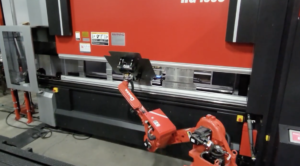
While sheet metal fabrication is often a subtractive process, there are many ways of using forming mechanisms to shape metal that don’t remove any material at all. Instead, a given force is applied to a piece of sheet metal to change its geometry. In order for this to happen, the force must be great enough to pressure the metal beyond its yield strength, but not so great that it fractures or breaks.
What is the most common type of metal forming?
“Bending” is the most common type of metal forming. Simple bending occurs when the metal’s shape is changed at only one axis point; however, complex parts can be created by applying additional operations to the piece. Metal bending is used to create V, U or channel shapes; all are created by press brakes. At EVS Metal, we have invested in a number of different machines for our bending processes so that we are able to achieve the exact requirements and tight tolerances our customers expect. We purchase and generally prefer European-style press brakes by Amada, including:
- (2) Amada HG 1003 ARs Press Brake with Automatic Tool Changer (ATC)
- Amada FAB III 8025 Astro 100 Robotic 8′
- Amada FAB III 1253 Astro 100 Robotic 10′
- Amada FAB III 1253 10′ 120 Ton
- (2) Amada HDS 1303 10′ 143 Ton
- (2) Amada FAB III 1025 8′ 100 Ton
- Amada FAB III 8025 8′ 80 Ton
- (2) Amada RG 3512 4′ 35 Ton
What are some common types of metal bending?
Although bending may sound simple, it’s actually far from that. In fact, there are multiple kinds and each has its advantages and drawbacks. The primary distinction between each type of bending is characterized by the relationship between the thickness of the material and the end tool position; the following gives a brief overview of several bending techniques and how they are used:
- Air bending forms material by pressing a punch (also called the upper or top die) into the material, forcing it into a bottom V-die, which is mounted on the press.
- Bottoming is the process of forcing a piece of sheet metal against the “V” opening in the bottom of the tool to create the “V” shape.
- Coining uses the top tool to force the metal into the bottom die with 5 to 30 times the force of air bending, causing permanent deformation. It is high precision, but also high cost.
- Additional types of bending include Folding, Wiping, Three-Point Bending, Rotary Bending, Elastomer Bending, Roll Bending and Joggling.
At EVS Metal, we pride ourselves on the state-of-the-art forming and bending equipment available at all four of our American manufacturing facilities. Discover how our top-of-the-line machines can add value to your manufacturing supply chain; simply request a quote online, or give us a call at (973) 839-4432 today.





